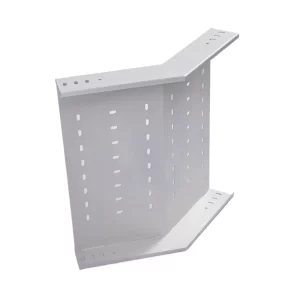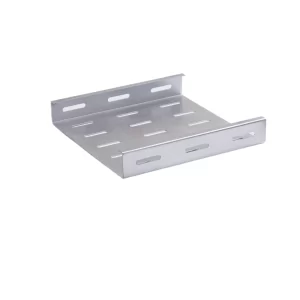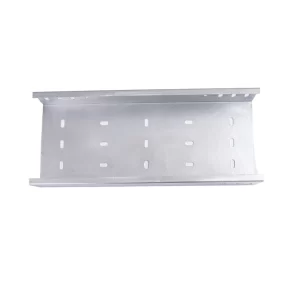Perforated cable trays are an essential component in cable management systems, providing a structured and organized way to route and support electrical cables. These trays are designed with perforations that offer several advantages, such as improved ventilation, reduced weight, and ease of cable installation. In this article, we will explore the places where perforated cable trays are most frequently found.
Perforated cable trays are widely used in various industries and applications due to their unique features and benefits. They are commonly found in commercial buildings, industrial facilities, data centers, and telecommunications installations. Understanding where these trays are most frequently used can help in the proper selection and installation of cable management systems.

Commercial Buildings
1. Office Buildings
In office buildings, perforated cable trays are often used to manage the large number of electrical and data cables required for computer networks, telephone systems, and other office equipment.
The perforations in the trays allow for air circulation, which helps to prevent overheating of the cables. This is particularly important in office environments where there is a high density of electronic equipment.
Perforated cable trays can be installed in ceilings, under raised floors, or along walls to provide a neat and organized cable routing solution.
2. Retail Stores
Retail stores also make extensive use of perforated cable trays to manage the cables for lighting, security systems, point-of-sale terminals, and other electrical equipment.
The trays can be installed in visible areas without detracting from the store’s aesthetics, as they often have a sleek and modern design.
The perforations allow for easy access to the cables for maintenance and troubleshooting, which is essential in a busy retail environment.
3. Hotels and Restaurants
Hotels and restaurants require reliable cable management systems to support their electrical and communication needs. Perforated cable trays are commonly used to route cables for lighting, audio-visual systems, and guest room amenities.
The trays can be installed in concealed areas such as false ceilings or wall cavities to maintain a clean and uncluttered appearance.
The perforations help to dissipate heat generated by the cables, ensuring the safety and reliability of the electrical systems.
Industrial Facilities
1. Manufacturing Plants
In manufacturing plants, perforated cable trays are essential for organizing and protecting the cables that power machinery, control systems, and other industrial equipment.
The trays can withstand the harsh environments found in manufacturing facilities, including exposure to dust, moisture, and chemicals.
The perforations allow for air circulation, which helps to prevent overheating of the cables and prolong their lifespan.
Perforated cable trays can be installed overhead or along walls to provide a safe and efficient cable routing solution.
2. Warehouses
Warehouses often have a large number of electrical cables for lighting, conveyor systems, and other equipment. Perforated cable trays are used to manage these cables and ensure a safe and organized working environment.
The trays can be installed at high levels to avoid interference with forklifts and other warehouse machinery.
The perforations allow for ventilation, which helps to prevent the buildup of heat and moisture in the cables.
3. Power Plants
Power plants require robust cable management systems to handle the large amounts of electrical power generated and distributed. Perforated cable trays are used to route cables for generators, transformers, and control systems.
The trays can withstand high temperatures and electromagnetic interference, making them suitable for use in power plant environments.
The perforations help to dissipate heat and provide ventilation for the cables, ensuring reliable operation.


Data Centers
1. Server Rooms
Data centers house a large number of servers, storage devices, and networking equipment, all of which require a reliable cable management system. Perforated cable trays are commonly used in server rooms to route the cables for power, data, and cooling.
The trays are designed to handle the high density of cables found in data centers and provide easy access for maintenance and upgrades.
The perforations allow for air circulation, which helps to cool the equipment and prevent overheating.
2. Network Closets
Network closets in data centers also use perforated cable trays to manage the cables for switches, routers, and other networking equipment.
The trays can be installed in a vertical or horizontal configuration to optimize space and cable routing.
The perforations provide ventilation and allow for easy identification and troubleshooting of cables.


Telecommunications Installations
1. Telephone Exchanges
Telephone exchanges require a reliable cable management system to handle the large number of telephone lines and communication cables. Perforated cable trays are used to route these cables and ensure proper organization and protection.
The trays can be installed in racks or on walls to provide a neat and accessible cable routing solution.
The perforations allow for air circulation and help to prevent signal interference.
2. Cell Towers
Cell towers also make use of perforated cable trays to manage the cables for antennas, base stations, and other telecommunications equipment.
The trays can be installed outdoors and are designed to withstand harsh weather conditions.
The perforations provide ventilation and help to dissipate heat generated by the equipment.
Perforated cable trays are most frequently found in commercial buildings, industrial facilities, data centers, and telecommunications installations. These trays offer several advantages, such as improved ventilation, reduced weight, and ease of cable installation. By understanding where perforated cable trays are commonly used, it is possible to select the right cable management solution for a specific application. Whether it’s in an office building, manufacturing plant, data center, or telecommunications installation, perforated cable trays play a crucial role in ensuring the safe and efficient routing of electrical cables.

